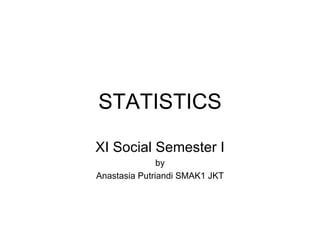Statistics1
- 1. STATISTICS XI Social Semester I by Anastasia Putriandi SMAK1 JKT
- 2. STATISTICS IN REAL LIFE âĒ Pemilihan ketua ketua kelas âĒ PEMILU âĒ Riset/Penelitian âĒ Apa lagi?
- 3. Kompas, Selasa 6 Juli 2010
- 4. STATISTICS
- 5. Pengumpulan dan Penyajian Data
- 6. Proses pengumpulan data Populasi Sampel x,s Âĩ, Ï Digunakan untuk menaksir
- 8. Table of Frequency Kompas, 3 Juni 2010, page 19
- 10. Barchart Kompas, 3 Juni 2010 page 18
- 12. Line Chart
- 13. STATISTICS
- 14. UKURAN PEMUSATAN/ MEASURES OF CENTRAL TENDENCY ( common averages: mean, median, mode) mean: regular meaning of "averageâ median: middle value mode: most often
- 15. For a probability distribution, the mean is also called the expected value of the random variable. For a data sample, the mean is also called the average
- 16. Student: Which one is better: mean, median or mode? âĒ Mentor: It depends on your goals. I can give you some examples to show you why. Consider a company that has nine employees with salaries of 35,000 a year, and their supervisor makes 150,000 a year. If you want to describe the typical salary in the company, which statistics will you use? âĒ Student: I will use mode (35,000), because it tells what salary most people get.
- 17. âĒ Mentor: What if you are a recruiting officer for the company that wants to make a good impression on a prospective employee? âĒ Student: The mean is (35,000*9 + 150,000)/10 = 46,500 I would probably say: "The average salary in our company is 46,500" using mean. âĒ Mentor: In each case, you have to decide for yourself which statistics to use. âĒ Student: It also helps to know which ones other people are using!
- 18. i x[i] Quartile 1 102 2 104 3 105 Q1 4 107 5 108 6 109 Q2(Median) 7 110 8 112 9 115 Q3 10 116 11 118
- 19. Bagaimana jika banyaknya data genap?
- 20. Upper and lower quartiles Data 6, 47, 49, 15, 43, 41, 7, 39, 43, 41, 36 Ordered data 6, 7, 15, 36, 39, 41, 41, 43, 43, 47, 49 Median 41 Range : 49-6 (Jangkauan) Upper quartile 43 Interquartile range : 43-15 [Q3-Q1] 15 Semi-quartile : (43-15)/2 [ Â― (Q3-Q1)] Lower quartile
- 21. UKURAN PENYEBARAN Measures of Spread
- 22. Box and whisker plots
- 23. âĒ The oldest person in Mathsminster is 90. The youngest person is 15. âĒ The median age of the residents is 44, the lower quartile is 25, and the upper quartile is 67. âĒ Represent this information with a box-and- whisker plot.
- 24. Ukuran pemusatan yang lain: 1. Simpangan rata-rata âĒ Simpangan rata-rata n â xi â x SR = i =1 n
- 25. 2. Ragam (Variance) (x ) n â 2 i âx s = 2 i =1 n
- 26. 3. Simpangan Baku (Standard Deviation) s= s 2


















![i x[i] Quartile
1 102
2 104
3 105 Q1
4 107
5 108
6 109 Q2(Median)
7 110
8 112
9 115 Q3
10 116
11 118](https://image.slidesharecdn.com/statistics1-120608034846-phpapp01/85/Statistics1-18-320.jpg)

![Upper and lower quartiles
Data 6, 47, 49, 15, 43, 41, 7, 39, 43, 41, 36
Ordered data 6, 7, 15, 36, 39, 41, 41, 43, 43, 47, 49
Median 41 Range : 49-6 (Jangkauan)
Upper quartile 43 Interquartile range : 43-15 [Q3-Q1]
15 Semi-quartile : (43-15)/2 [ Â― (Q3-Q1)]
Lower quartile](https://image.slidesharecdn.com/statistics1-120608034846-phpapp01/85/Statistics1-20-320.jpg)





